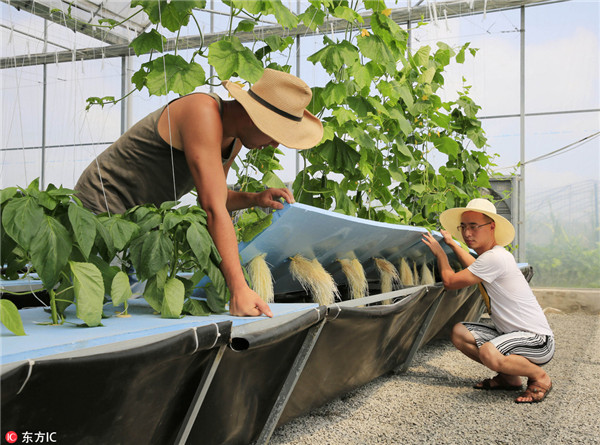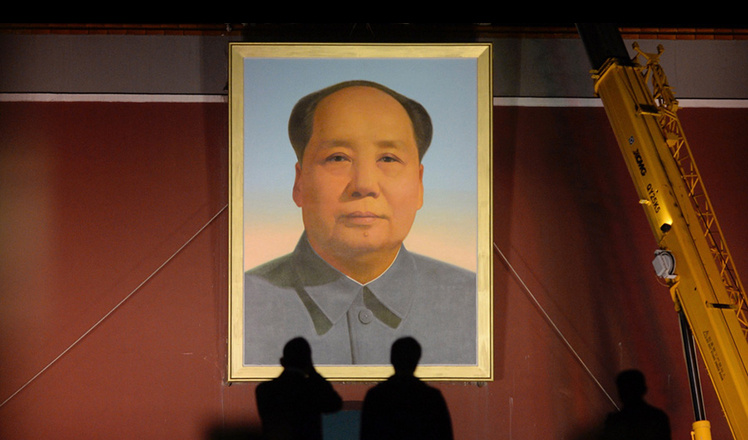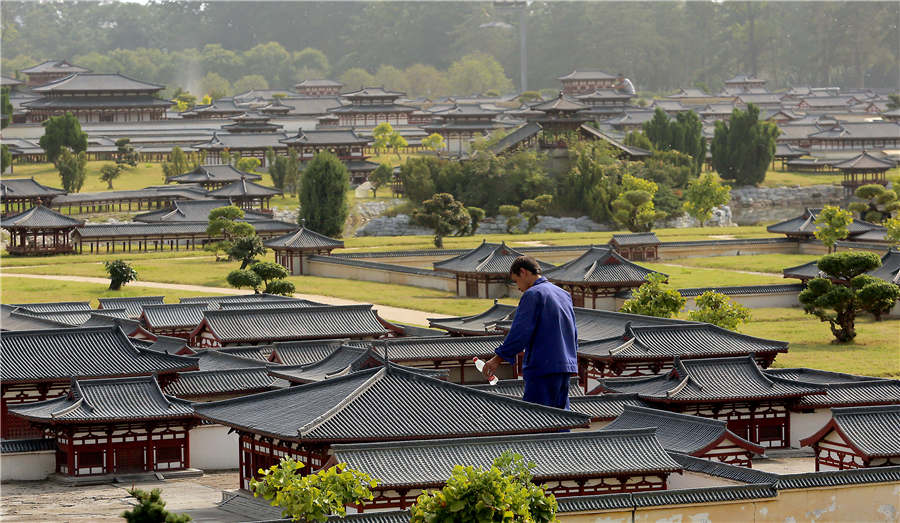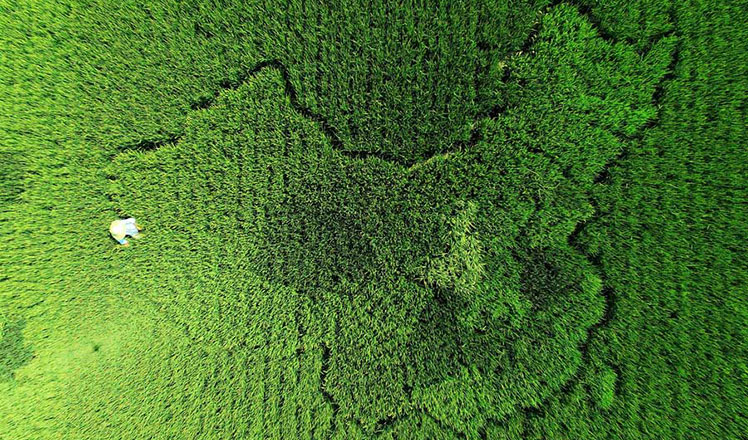Analysis of the US challenge against China's grain support policies
Updated: 2016-09-28 16:07
By Tang Zhong(chinadaily.com.cn)
|
||||||||
 |
|
People check on plants in an eco-farm in Nantong,Jiangsu on August 7, 2016. [Photo/IC] |
On September 13th, 2016, The United States initiated WTO dispute proceedings against China regarding China's domestic support in favor of agricultural producers of, among other crops, wheat, Indica rice, Japonica rice, and corn. The US claimed that China had provided domestic support to the products mentioned above in excess of its WTO accession commitment, and has violated the Agreement on Agriculture.
As the largest exporter of agricultural products, the US, with large production scale and strong competitiveness, produces agricultural commodities mainly for export. By contrast, China is the largest importer of agricultural products, with its agriculture characterized by small scale production and subsistence farming. The average production scale of China per household is only 1/400 of that of the US. Suffice it to say, the US and China are the typical examples of commercial agriculture and subsistence agriculture. By its nature, initiating WTO dispute proceedings against China by the US represents the conflict between interests of large commercial farmers in the US and livelihood of small holder farmers in China. How to comment on this? Has China, the biggest market for US agricultural products, harmed the commercial interests of the US large farm owners by providing subsidies to small farmers? With the impact of excessive import of agricultural commodities being intensified on China, how can livelihood of small farmers be secured?
I. Digging into the impact of US agricultural products exported to China, it is the commercial interests of the US that harm the livelihood of small Chinese farmers.
China, after its WTO accession, has a highly open agricultural market. As a result, the US, with its farm exports swarming into China, has caused sustained harm to small Chinese farmers. Since 2001, the US has exported its agricultural products to China at an increasing speed, from less than 2.8 billion dollars to 28.8 billion dollars at its peak, doubling every four years. The average trade deficit of China to the US in terms of agricultural products has reached 20 billion dollars annually, and China has become the largest export market for US agricultural products.
In recent years, the large amount of agricultural products imported by China has caused increasingly severe impact on Chinese agriculture, from which small farmers suffered a lot. With farmers' income being affected, China is now facing huge pressure in agricultural restructuring. Before 2010, imports such as soybean and cotton from the US impacted China's production by suppressing its growth, by taking the market share of Chinese products, and thus prevented the increase of domestic production that would have occurred following the growth of domestic consumption. From 2001 to 2010, Chinese soybean consumption has increased by nearly 150%, and cotton, 100%. However, the production of soybean has stagnated, whereas cotton has only increased 12%. In the meantime, China has imported 3.1 times more soybean and 15.2 times more cotton from the US than in 2001. After 2011, the impact has turned into real direct suppression. The excessive imports of soybean and cotton have caused a decrease of sown area of 46 million mu (3.07 ha) and 32 million mu (2.13 ha) respectively for these two products, and a decrease of production of 5.6 million tons and 2 million tons respectively. Divided by average production area per household in China, the excessive import of these two products has done harm to the employment and livelihood of 50 million farmers.
The reason why small farmers in China have suffered from commercial exports of the US products is that China's agriculture lacks basic competitiveness due to its small scale. In addition, a highly open market has, to a great extent, limited China's instruments of regulating the market. The US, with its subsidies to agriculture, has strengthened its competitiveness.
China has made significant commitments in WTO accession. With the elimination of non-tariff measures, such as quantitative restrictions and licensing, tariff and tariff quota have become the only two instruments for China to regulate agricultural trade. However, the average tariff rate of China's agricultural products is only 15.2%, which is 1/4 of the world average. In addition, China has ad valorem only tariff, and there is no overhang between the bound and applied tariff. China has also made a commitment of not using SSG to protect domestic production in times of import surges. The weighted average tariff is only 3.6% for major agricultural products that the US exported to China, such as edible oil seeds, cotton, grain, animal products, and dairy products.
China is by far the most open market of agricultural products in the world. From China's accession to WTO to 2015, the import volume of China in terms of agricultural products has increased from 11.8 billion dollars to 116.9 billion dollars, an annual increase of 17.8%, and a deficit of 46.2 billion dollars. China is now the largest importer of agricultural products, and in the front pack of importing products such as soybean, rapeseed, rice, barley, sorghum, cotton, sugar and milk powder. As China's largest source of imports, the US has already made great profits from exporting agricultural products to China. In the meantime, the US has provided large subsidies to agriculture, so as to enhance its competitiveness and export more to China.

 Real life 'Transformer' car turns into robot
Real life 'Transformer' car turns into robot
 Israel's ex-president Peres dies at 93
Israel's ex-president Peres dies at 93
 New Mao Zedong's portrait graces Tian'anmen
New Mao Zedong's portrait graces Tian'anmen
 Clinton, Trump go head to head in high stakes presidential debate
Clinton, Trump go head to head in high stakes presidential debate
 Miniature replica of Daming Palace shows craftsmanship
Miniature replica of Daming Palace shows craftsmanship
 Elderly man creates map of China with colorful rice
Elderly man creates map of China with colorful rice
 Students 'die' to get closer to each other in Hangzhou
Students 'die' to get closer to each other in Hangzhou
 Classic autos debut at Beijing Design Week
Classic autos debut at Beijing Design Week
Most Viewed
Editor's Picks

|

|

|

|

|

|
Today's Top News
Trump outlines anti-terror plan, proposing extreme vetting for immigrants
Phelps puts spotlight on cupping
US launches airstrikes against IS targets in Libya's Sirte
Ministry slams US-Korean THAAD deployment
Two police officers shot at protest in Dallas
Abe's blame game reveals his policies failing to get results
Ending wildlife trafficking must be policy priority in Asia
Effects of supply-side reform take time to be seen
US Weekly

|

|







